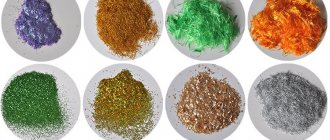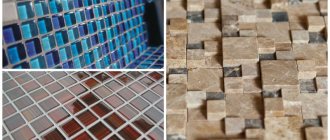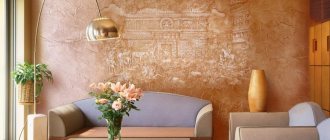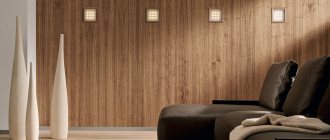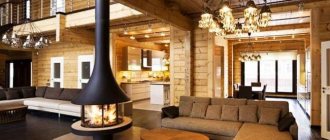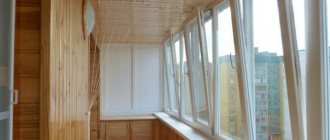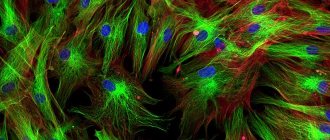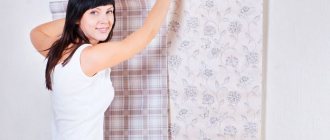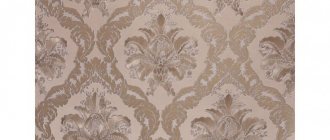Applying liquid wallpaper, taking into account all the features of the finishing material, is not a difficult process to master. The length of its service depends on the correct preparation of the wall, preparation of the mass and application of silk plaster. Surely each of us has performed unfamiliar work at least once in our lives. Only after completion do you understand that everything was much simpler - you just had to follow the technology and study the issue a little in advance. We tried to make our article just such a methodological guide.
Surface preparation
The durability of the coating, first of all, depends on the quality of surface preparation carried out before gluing liquid wallpaper. “Liquid” material is not intended for leveling the wall, so you need to take care of priming and cleaning the base in advance. It is possible that during the preparatory work circumstances will become clear that prevent the use of wallpaper material, and it will have to be replaced with decorative plaster or other finishing.
Depending on the condition of the walls, it is necessary to perform one or more of the following operations.
- Remove paper wallpaper from the wall and wash off the whitewash. Such coatings cannot be used as a substrate. The paint layer is checked for strength of adhesion to the walls; if peeling or peeling, the paint is removed.
- Examine the plaster. Be sure to tap the walls to look for peeling areas and other defects. If the paint and plaster are in poor condition, they are removed completely or locally, and the plaster is repaired.
- Small cracks in the plaster can be easily covered with wallpaper, while large cracks can be repaired.
- If the surface of the wall is too uneven, then you need to level the base with a layer of plaster along the beacons. Small differences will be covered with wallpaper paste.
- Places where mold or rot has settled are washed with mandatory treatment with fungicidal liquids. The rust is cleaned off. Metal products are painted over for insulation with oil paint or other insulating agent. The efflorescence is washed off and the cause of its appearance is determined. It may be necessary to waterproof the area.
- Since the wallpaper mass weighs little and is applied in thin layers, there is no need to reinforce the base. However, at the joints of structures, you can pre-glue sickle tape followed by putty.
The smooth paint layer is sanded to increase adhesion.
A primer is required before applying liquid wallpaper. For example, smooth surfaces are primed to increase adhesion. You cannot do without applying a primer in the case of wooden and porous walls.
Liquid wallpaper requires a primer with quartz sand. Typically these primers are white in color and do not require white painting. If the paint or other finishing on which a lot of liquid wallpaper is applied is not white, then for light wallpaper the wall must be painted with white paint or covered with white putty. The areas where the rust has been removed are also painted as a preventative measure.
The primer is applied in two or three passes. Each time the wall is dried.
The frames of windows, doors, sockets and switches are sealed with masking tape. The wiring is de-energized. The floor and abandoned furniture are covered with film. Although the wallpaper mass remains plastic for a long time and is washed off, it is better to take care of protection.
The most “successful” base materials:
- leveled plaster;
- fiberglass;
- clay;
- drywall (preliminarily putty the entire surface);
- primed polystyrene foam;
- concrete or stone.
Less “successful”, but also suitable after priming:
- metal;
- OSB;
- tree;
- Fibreboard, chipboard, MDF.
Liquid wallpaper compositions cannot be applied directly to plywood, since the top plywood layer “shrinks.”
Environmental conditions
Artificial materials (finishing mixtures) require certain conditions for preparation, application, and curing; liquid wallpaper for walls is no exception. How to apply such compositions, under what conditions? What are the differences from plastering work?
Basic requirements for application conditions:
- It is allowed to work with the window slightly open, but drafts are harmful.
- The temperature range is narrower than for plaster. Optimal limits are from 17 to 25 degrees with normal humidity. Below +10°C the work is not performed.
- Heating devices are not used.
Ensure good lighting of the room and, above all, of the wall being treated.
Application of liquid wallpaper
Stock up on tools in advance. Applying liquid wallpaper is impossible without tools; you will need a metal or plastic (preferably transparent) grater, spatula and trowel. Compositions of a less thick consistency can be applied using rollers (ribbed or sparsely piled). If the mass is not applied manually, then you need a cartouche (texture) gun connected to a compressor.
You will also need:
- container for diluting dry mixture;
- tape measure for marking the wall (not in all cases);
- clean rags;
- roller or brush for priming;
- masking tape;
- knife for opening containers;
- water dosage measure;
- container with water.
It is advisable to apply the composition starting from the light corner towards the dark one. Finishing is carried out in daylight and artificial light.
You can apply wallpaper mass:
- mechanically;
- trowel or spatula;
- roller;
- just with your hands, immediately forming the stucco molding.
The composition, prepared in advance, is applied in sections, applying a layer of solution of 2-3 mm. The applied mass is immediately leveled. Then cover the adjacent area, achieving the same layer thickness over the entire surface. The main thing is to get a seamless finish.
In case of unsuccessful application, the composition can be further moistened and removed with a spatula. After this, a new portion of the solution is applied, comparing the thickness of the layer with the surrounding finish.
Final smoothing is best done with a plastic float. Before use, the instrument is wetted. During leveling, the grater is also moistened with water periodically. This makes it easier to achieve a smooth surface.
Let us consider in detail each of the above methods.
Plastic trowel
The tool is good because it is light. Correct application of liquid wallpaper is accessible not only to experienced plasterers, but also to beginners. The mass is applied to the trowel with a spatula, then, holding the trowel at an angle to the wall, the composition is transferred to the base. This is done in the same way as applying plaster mortar. You can even apply the wallpaper composition using a grater. If the composition sticks to the tool, the working surfaces are moistened with water.
There is no need to apply excessive pressure on the trowel. There is no need to rush. The composition can be corrected at any time: add (if necessary) dough where the layer thickness is lacking, remove excess. It can take from 12 to 72 hours for the material to set.
Periodically look at the laid coating at an angle, illuminating the surface from the side. This helps identify processing deficiencies. Against the light, voids or poorly executed transitions are clearly visible.
The application sequence is as follows:
- preparation of the composition;
- wall preparation;
- applying the mass manually;
- leveling with a grater or trowel;
- drying the coating.
With a cartouche pistol
To create a seamless coating, it is unacceptable to join together already hardened wallpaper and fresh mass when creating a finish (this is only possible during repairs). Therefore, it is better to process large-area walls using a texture gun (installing a large nozzle).
Some compositions are produced specifically for application with pneumatic tools. With the help of a mechanical assistant, the application of liquid wallpaper is accelerated. With experience, the applied mass can be laid evenly. If there is no experience, then additional leveling with hand tools will be required. The lifespan of the composition allows you to do this slowly.
For a cartouche pistol, you will need a compressor capable of delivering 2-3 atm, with a capacity of 250 l/min.
Subsequence:
- preparing the solution;
- preparation of the base;
- preparation of equipment (connection to a compressor);
- applying the composition;
- surface leveling;
- disconnecting the gun, washing and drying the device parts;
- drying the walls.
In reality, such a tool is most often used by professional finishers when working on large areas.
Drawings with liquid wallpaper
The material allows you to create various images. These can be oriental ornaments, abstract pictures, plant and floral motifs, figures of people or animals. In children's rooms, the walls can be decorated with a castle or a fairy-tale plot. Here you can completely surrender to the creative process. The technique of applying patterns on the wall with your own hands depends on the clarity of the shapes and what you ultimately want to get.
Basic techniques for creating a drawing:
- Using a stencil.
- DIY drawing.
- Relief.
Let's describe each of them.
The simplest way to apply patterns is to use a stencil. The stencil itself can be purchased or made by hand. The stencil is placed on the wall and secured with masking tape. A layer of mortar is applied on top of it and leveled with a spatula or trowel. Remove the stencil without waiting for the mass to start setting.
Another technique is artistic painting. The technique is more complicated than stenciling. If you have no experience, then you should practice separately. Fortunately, the material is easily removed, and you can try it many times.
applying wallpaper along the contour of the pattern on the wall
filling the background of the future drawing
the result of drawing a picture on the wall
The technique is reminiscent of painting with a brush. Prepare wallpaper mass of the desired colors, with a more liquid consistency. Draw the main lines of the pattern on the wall with a pencil. The material is applied with a brush, palette knives or narrow spatula, filling the pattern.
In order not to accidentally “blur” the mass beyond the line of the pattern, you can stick a strip of masking tape on the wall along the border of the pattern.
Relief images look beautiful. Most often they are created by combining stencil techniques and modeling. Additionally, patterns can be decorated with unexpected inlays made of foil, beads and other elements, including those made specifically for your image.
What you can't do without: tools
It is impossible to clearly identify the list of necessary devices for working with liquid wallpaper. The uniqueness of the material is that it can be applied with almost any available means, and it is worth starting from those devices that the home craftsman has at his disposal or from his experience in handling other types of finishing - putty, paint, plaster.
USEFUL INFORMATION: Installing drywall on a wall without a frame
The consistency of the finished solution is also important, which can vary in degree of thickness. In one case it will be easier to use a roller for coating, and in another - a trowel or spatula. And when there is a need to treat a large area, it is better to use a textured spray gun (gun) with a large nozzle.
So, the following are suitable for work:
- Graters.
- Trowels (a special transparent plastic trowel is shown in the photo below).
- Plastic or metal spatulas.
- Hopper pistol.
- Rollers (with a sparse pile - for application, ribbed - to create texture).
How to breed at home
The packaging containing the dry mixture contains instructions for proper mixing and preparation of the mixture for use.
The manufacturer’s recommendations should not be violated, since their implementation guarantees the receipt of a high-quality finishing mass.
We provide only general information. The entire volume of the mixture contained in the package should be diluted at once.
Instructions for preparing the mixture
You will need clean warm water. Tap water or strained rainwater will do. Heat is necessary to soak and swell the adhesive granules and form a gel. In a cold liquid, the process will proceed slowly, so the specified holding time may not be enough.
pour the dry mixture into a container
to stir thoroughly
- The water is not poured all at once. Leave about half a liter. This liquid is added after the curing mass has been kept for the required time.
- Having poured water, add separately purchased decorative components (glitter, mother-of-pearl, granules) into the container and mix. The dry mixture is kneaded in a bag and poured into a container.
- If you use a mixer for mixing, the fibers of the mixture are torn during stirring and the decorative inclusions are damaged. The structure of the wallpaper will be damaged. Therefore, the mixture is stirred and kneaded with hands. Separately added glitter should be evenly distributed throughout the entire mass. While stirring, the mixture swells and becomes similar to mashed potatoes, which must be made without lumps.
- The entire mixture is placed in a plastic bag and tied tightly, or the container with the mixture is hermetically covered with film. Leave to “simmer” for the time specified in the instructions (approximately 8-12 hours). Only after this the mass will be ready.
- If you need more mixture for application than can be obtained from one package, then after preparing the first batch, put the composition on film, and dilute another batch in the empty container. We combine the resulting masses, mix on the film and roll up a “package” from the film. We seal the edges of the bag with tape to create an airtight seal.
- After waiting for “readiness”, put the required amount of mass into the container, add the reserved water and mix the mixture again before applying.
For mechanical application, the consistency of the mixture is made similar to thick sour cream.
For a seamless finish, you need to prepare enough dough to cover the entire wall.
How long can you store diluted?
This question worries those who are getting acquainted with the material for the first time. The finished composition is stored for approximately 2-4 days in room conditions. The main thing is that it is closed hermetically. No refrigerator is needed for storage.
A pleasant property of the liquid wallpaper material was the ability to dry the diluted mass and then reuse it. If you have finished decorating the room, and the prepared dough is still left, spread it in a thin layer on film, metal (stainless) sheet or glass. In a day the material will dry. It needs to be collected, put in a dry bag, hermetically sealed, and placed in a dark, dry place.
The remainder will be useful for local repairs or restoration of damage. It will have the same composition and the same color shade as the restored finish.
Protective varnish
To protect against accidental ingress of moisture during the operation of liquid wallpaper, varnish is applied to the wall. In this case, be sure to take into account the characteristics of the wallpaper. For example, after coating, the surface takes on a rougher appearance, and the color tone may even change slightly.
The charm of the softness and airiness of fabric upholstery disappears. The finish loses vapor permeability. Therefore, it is recommended to use varnish only where contact with water is possible (in the kitchen sink area, in the bathroom).
Finishers do not recommend varnishing materials from the Recoat 1 (2, 3) liquid wallpaper collections. This material contains wood and other adhesives that may cause stains.
Special varnishes are produced for varnishing silk plaster. You can apply regular acrylic varnish (it is advisable to do a test). Apply the varnish with a brush or medium-pile roller in two or three layers. After each pass, dry the varnish for at least 6 hours. Drying time for the last layer is up to one and a half days (according to the instructions).
Subsequent finishing
The disadvantage of standard liquid wallpaper is that it is not resistant to water. Therefore, to use them, for example, in the kitchen or bathroom, you will have to resort to additional processing.
USEFUL INFORMATION: How to level the walls in an apartment with wallpaper with your own hands (video)
To clog the pores and protect the material from moisture, use acrylic varnish. After impregnation, liquid wallpaper can be washed and not be afraid that it will become deformed due to high humidity. Varnishing the bottom of the wall is also often used, for example in children's rooms where there is a need for a durable coating. But at the same time, you need to remember that the surface will lose its “breathing” qualities, and there will also be difficulties if you need to restore the damaged area.
Sometimes you can find special impregnations for liquid wallpaper on sale. But their use is not always advisable due to their high cost and low prevalence in retail chains.
Repair of liquid wallpaper
Silk plaster is not as durable as true decorative plaster, so it is more easily damaged. It is less resistant to abrasion. If the finish is damaged or the expiration date has expired, then restoring liquid wallpaper with your own hands will not be difficult. Especially if you have dried excess stock.
The damaged finish is removed, and the cleaned area is covered with a new solution.
Material selection
It is easier to apply liquid wallpaper with medium-sized additives with your own hands. Too small fractions in the mixture require more careful leveling over the surface, and a beginner’s skills may not be enough for this. Decorative elements that are too large in wallpaper must be applied with great care, as they are very easy to damage and spoil.
The range of coatings and the rules for their selection are in the video:
If the owner plans to make a drawing from liquid wallpaper, he must first make a sketch. Then transfer the drawing to the wall. To do this, you can only use a simple pencil - colored pencils, markers and felt-tip pens can subsequently appear through the coating layer.
If you plan to work with a stencil, you must first apply an even base coat. After it dries, an ornament is made using a pattern and a mixture of a contrasting color.
Mixture consumption
In practice, the mixture consumption declared by the manufacturer is often exceeded. Therefore, it is necessary to calculate the number of packages that need to be purchased for repairs with a reserve. About 20% of the supply should be enough even for a beginner. The excess will be useful in the future, and you won’t find yourself in a situation where you can’t find an identical mixture to finish the rest of the wall.
Consumption depends on several conditions, for example, the thickness of the applied layer, the volume of waste due to lack of experience. When calculating the area of the walls, it is better to calculate the number of packages, reducing the number of squares that can be covered according to the manufacturer's figures.
Is it possible to apply liquid wallpaper to plaster?
This is a frequently asked question, to which we will devote a short, but hopefully very informative paragraph. So, a combination of two finishing materials: a plaster base and applying liquid wallpaper on top of it is the best of other combinations. However, you should check the existing plaster for strength and defects.
Applying liquid wallpaper is much simpler and easier than plastering walls. You won’t have time to get too tired, and you’ll create the finished finish in less time. If you follow the instructions, the liquid wallpaper applied by yourself will be pleasing to the eye and will last as long as possible for this material.
Important to consider
In addition to the price, there is also a technical aspect, which most likely should be listed as a disadvantage. Like textured plaster, liquid wallpaper is applied directly to the wall, and if it has differences in surface composition or unevenness, all these defects will eventually appear on top of them. The presence of several layers of old paint, uneven putty or plaster, differences in level, and, consequently, the thickness of the wallpaper layer, metal objects coming to the surface (screws, nails, fittings, pipes) - all this will ultimately spoil the appearance of the result.
